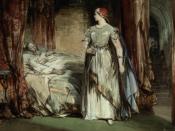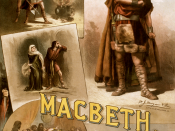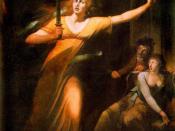In William Shakespeare's "Macbeth", symbolism is often used in showing the overall theme of murder. There are several distinguishing forms of this throughout the play. The contrast of light and dark, representing good and evil, plays a major role in the sequence of the events in the play. Blood symbolizes murder and guilt. The classical form of cleaning by water, is used several times in the play, mainly in the murder scenes. Symbolism is widely displayed in order to achieve the general topic of evil.
Light and dark represent good and evil in the play. During the time in which "Macbeth" was written, the king was associated with the sun. The sunset symbolized his death. The quotes "When shall we three meet again . . . " and "That will be ere the set of sun." (I. i. 1,4) foreshadow the king's death. The viewing of light and dark is used several times throughout the play.
"Stars, hide your fires; Let not light see my black and deep desires." (I. iv. 50-51) demonstrates Macbeth's transition evil. Most of the corrupt and disturbing events in Macbeth occur under darkness it seems. The murders, Lady Macbeth's sleepwalking, and the appearance of the witches, all take place at night. Lady Macbeth's sleepwalking scene is another example of the light and darkness symbol. She once wanted the darkness but now carries a candle to try and forget about it. The line, "She has light by her continually; 'tis her command." (V. i. 19), symbolizes Lady Macbeth's fear of darkness and evil.
The image of blood plays a vital role in the event of Duncan's murder. It represents Macbeth's guilt and shame about the gruesome, heart wrenching crime. After killing the king, Macbeth comments on his hands while they appear to be...


